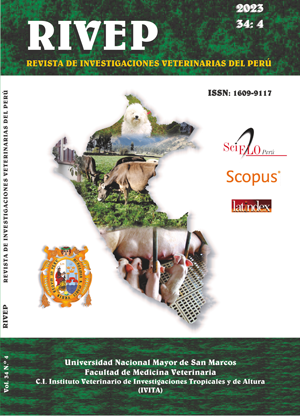Diagnostic evaluation of agrodiversity and sustainability of small farms that grow corn in Ecuador
DOI:
https://doi.org/10.15381/rivep.v34i4.23852Keywords:
agroecology, agroecosystems, rapid participatory characterization, detailed participatory characterization, agricultural production unitsAbstract
The study was carried out in small Agricultural Production Units (UPA) that grow corn in the Cuatro Vientos and Lomas de Mera villages of the Mocache canton, humid tropics of Ecuador in order to evaluate the composition of agrodiversity and its relationship with its sustainability. The rapid characterization consisted of identifying the perceived problems and the state of agrodiversity on the farms, through direct observation and semi-structured interviews. For the detailed characterization, standardized and weighted sustainability indicators were used according to their importance in the sociocultural, economic and environmental dimensions. Farmers had a limitation on the low costs of the products since there was no price stability. The local hybrid INIAP H-551 continues to be managed under conventional practices. The planned agrodiversity influenced the similarity of the farms between both villages. Likewise, the Cuatro Vientos village maintained the greatest progressive change from the cultivation of corn to the cultivation of cocoa, resulting in the inverse relationship by increasing the loss of agrodiversity and providing the lowest values on the general sustainability index.
Downloads
Downloads
Published
Issue
Section
License
Copyright (c) 2023 Fabricio Fabián Meza Bone, Gary Alex Meza Bone, Jesica Mariana Cachipuendo Castillo, Kimberlyn Yomira Cevallos Mayorga, Joel Cabrera Moreira, Carlos Javier Meza Bone, Jesica Sayonara Meza Bone, María Cabanilla Campos, Judith Catalina Cachipuendo Castillo, Guberth Ivan Cachipuendo Castillo, Johnny Enrique Novillo Celleri

This work is licensed under a Creative Commons Attribution 4.0 International License.
AUTHORS RETAIN THEIR RIGHTS:
a. Authors retain their trade mark rights and patent, and also on any process or procedure described in the article.
b. Authors retain their right to share, copy, distribute, perform and publicly communicate their article (eg, to place their article in an institutional repository or publish it in a book), with an acknowledgment of its initial publication in the Revista de Investigaciones Veterinarias del Perú (RIVEP).
c. Authors retain theirs right to make a subsequent publication of their work, to use the article or any part thereof (eg a compilation of his papers, lecture notes, thesis, or a book), always indicating the source of publication (the originator of the work, journal, volume, number and date).










